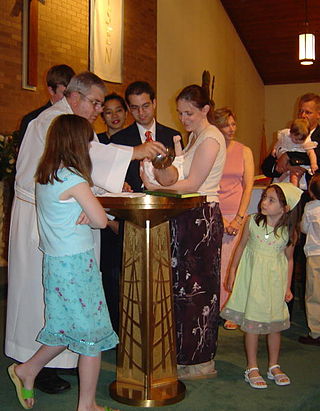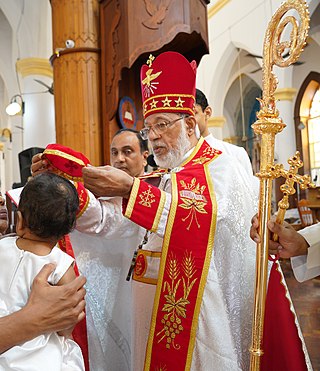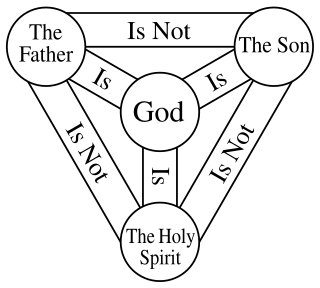Related Research Articles
Anabaptism is a Christian movement which traces its origins to the Radical Reformation in the 16th century. Anabaptists believe that baptism is valid only when candidates freely confess their faith in Christ and request to be baptized. Commonly referred to as believer's baptism, it is opposed to baptism of infants, who are not able to make a conscious decision to be baptized.

Baptism is a Christian sacrament of initiation almost invariably with the use of water. It may be performed by sprinkling or pouring water on the head, or by immersing in water either partially or completely, traditionally three times, once for each person of the Trinity. The synoptic gospels recount that John the Baptist baptised Jesus. Baptism is considered a sacrament in most churches, and as an ordinance in others. Baptism according to the Trinitarian formula, which is done in most mainstream Christian denominations, is seen as being a basis for Christian ecumenism, the concept of unity amongst Christians. Baptism is also called christening, although some reserve the word "christening" for the baptism of infants. In certain Christian denominations, such as the Catholic Churches, Eastern Orthodox Churches, Oriental Orthodox Churches, Assyrian Church of the East, and Lutheran Churches, baptism is the door to church membership, with candidates taking baptismal vows. It has also given its name to the Baptist churches and denominations.

Infant baptism is the practice of baptizing infants or young children. Infant baptism is also called christening by some faith traditions.

Chrismation consists of the sacrament or mystery in the Eastern Orthodox, Oriental Orthodox and Eastern Catholic churches, as well as in the Assyrian Church of the East initiation rites. The sacrament is more commonly known in the West as confirmation, although some languages such as Italian, Maltese and Portuguese normally use the terms cresima, griżma (tal-isqof) and crisma ("chrismation") rather than confermazione, konferma or confirmação, respectively ("confirmation").

Ordination is the process by which individuals are consecrated, that is, set apart and elevated from the laity class to the clergy, who are thus then authorized to perform various religious rites and ceremonies. The process and ceremonies of ordination vary by religion and denomination. One who is in preparation for, or who is undergoing the process of ordination is sometimes called an ordinand. The liturgy used at an ordination is commonly found in a book known as an Ordinal which provides the ordo for celebrations.

In Christian denominations that practice infant baptism, confirmation is seen as the sealing of the covenant created in baptism. Those being confirmed are known as confirmands. For adults, it is an affirmation of belief. The ceremony typically involves laying on of hands.

The Trinitarian formula is the phrase "in the name of the Father, and of the Son, and of the Holy Spirit", or words to that form and effect, referring to the three persons of the Christian Trinity. It is often followed by an "amen".

Closed communion is the practice of restricting the serving of the elements of Holy Communion to those who are members in good standing of a particular church, denomination, sect, or congregation. Though the meaning of the term varies slightly in different Christian theological traditions, it generally means that a church or denomination limits participation either to members of their own church, members of their own denomination, or members of some specific class. This restriction is based on various parameters, one of which is baptism. See also intercommunion.
A conditional baptism is a baptism performed in such a way as to only be effective if the person is not already baptized. In a conditional baptism, the minister of the sacrament says:
"If you are not yet baptized, I baptize you in the name of the Father and of the Son and of the Holy Spirit."

Infant communion, also known as paedocommunion, refers to the practice of giving the Eucharist, often in the form of consecrated wine mingled with consecrated bread, to young children. This practice is standard throughout Eastern Christianity, where communion is given at the Divine Liturgy to all baptized and chrismated church members regardless of age. Infant communion is less common in most of Western Christianity.
Firmilian, Bishop of Caesarea Mazaca from c. 232, was a disciple of Origen. He had a contemporary reputation comparable to that of Dionysius of Alexandria or Cyprian, bishop of Carthage. He took an active part in the mid-3rd century controversies over rebaptising heretics and readmitting lapsed Christians after the persecutions of Decius and was excommunicated by Pope Stephen I for his position. A single letter of Firmilian to Cyprian survives among Cyprian's correspondence. Jerome omits Firmilian from De viris illustribus. "To his contemporaries his forty years of influential episcopate, his friendship with Origen and Dionysius, the appeal to him of Cyprian, and his censure of Stephanus might well make him seem the most conspicuous figure of his time" (Wace).
Validity and liceity are concepts in the Catholic Church. Validity designates an action which produces the effects intended; an action which does not produce the effects intended is considered "invalid". Liceity designates an action which has been performed legitimately; an action which has not been performed legitimately is considered "illicit". Some actions can be illicit, but still be valid.
In keeping with its prevailing self-identity as a via media or "middle path" of Western Christianity, Anglican sacramental theology expresses elements in keeping with its status as a church in the catholic tradition and a church of the Reformation. With respect to sacramental theology the Catholic tradition is perhaps most strongly asserted in the importance Anglicanism places on the sacraments as a means of grace, sanctification and forgiveness as expressed in the church's liturgy.

The sacrament of holy orders in the Catholic Church includes three orders: bishops, priests, and deacons, in decreasing order of rank, collectively comprising the clergy. In the phrase "holy orders", the word "holy" means "set apart for a sacred purpose". The word "order" designates an established civil body or corporation with a hierarchy, and ordination means legal incorporation into an order. In context, therefore, a group with a hierarchical structure that is set apart for ministry in the Church.

An emergency baptism is a baptism administered to a person in immediate danger of death. This can be a person of any age, but is often used in reference to the baptism of a newborn infant. The baptism can be performed by a person not normally authorized to administer the sacraments.

John the Baptist, who is considered a forerunner to Christianity, used baptism as the central sacrament of his messianic movement. Christians consider Jesus to have instituted the sacrament of baptism. The earliest Christian baptisms seem to have been done either by immersion or by pouring water on the head three times. By the third and fourth centuries, baptism involved catechetical instruction as well as chrismation, exorcisms, laying on of hands, and recitation of a creed. In the West, affusion became the normal mode of baptism between the twelfth and fourteenth centuries, though immersion was still practiced into the sixteenth. In the sixteenth century, Martin Luther retained baptism as a sacrament, but Swiss reformer Huldrych Zwingli considered baptism and the Lord's supper to be symbolic. Anabaptists denied the validity of infant baptism, which was the normal practice when their movement started and practiced believer's baptism instead. Several groups related to Anabaptism, notably the Baptists and Dunkards, soon practiced baptism by immersion as following the Biblical example.

There are seven sacraments of the Catholic Church, which according to Catholic theology were instituted by Jesus Christ and entrusted to the Church. Sacraments are visible rites seen as signs and efficacious channels of the grace of God to all those who receive them with the proper disposition.

In Reformed theology, baptism is a sacrament signifying the baptized person's union with Christ, or becoming part of Christ and being treated as if they had done everything Christ had. Sacraments, along with preaching of God's word, are means of grace through which God offers Christ to people. Sacraments are believed to have their effect through the Holy Spirit, but these effects are only believed to accrue to those who have faith in Christ.
In the Catholic Church, communicatio in sacris, also called communicatio in divinis or communicatio in ritibus, designates the regulations for the partaking of a Catholic person to a non-Catholic sacrament or liturgical celebration, or for the partaking of a non-Catholic person to a Catholic sacrament or liturgical celebration. The expression is also used to refer to said acts of partaking themselves.
A conditional sacrament or sacramentsub conditione is in some Christian denominations a sacrament administered "on the condition that the faithful [receiving it is] able and legitimately entitled to receive the sacrament". An example of conditional sacrament is conditional baptism.
References
- ↑ Scott Culpepper, Francis Johnson and the English Separatist Influence (Mercer University Press 2011), p. 203 ISBN 978-0-88146-238-8
- ↑ "Cult Help and Information". Archived from the original on 28 June 2017.
- 1 2 CCC 1256.
- ↑ CCC 1284.
- ↑ 1983 CIC, Can. 869.
- ↑ Breck, Fr John (January 2010). "Baptism in Christ". www.oca.org. Retrieved 30 January 2022.
- ↑ "The Russian Orthodox Church Outside of Russia - Official Website". www.synod.com. Retrieved 30 January 2022.
- ↑ "John H. Erickson, "The Reception of Non-Orthodox into the Orthodox Church: Contemporary Practice" in St Vladimir's Theological Quarterly 41 (1997) pp. 1-17" (PDF).
- ↑ "Re-Baptism?". Third Millennium Ministries. Retrieved 11 April 2021.
- 1 2 Pappas, Shannon (17 March 2010). "Baptism from a Presbyterian Perspective" (PDF). FPCSM. p. 4. Archived from the original (PDF) on 8 September 2017. Retrieved 19 August 2023.
- ↑ Wuthnow, Robert. "Anabaptists." In Encyclopedia of Politics and Religion, 2nd ed.edited by Wuthnow, Robert, 26-29. Washington, DC: CQ Press, 2007. https://doi.org/10.4135/9781483300535.
- ↑ Doctrine and Covenants 22
- ↑ "Should You Be Baptized Again?". Awake!: 26–27. 8 January 1994.
- ↑ "J. O. Olson, "Should We Rebaptize?"".